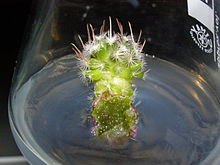Murashige and Skoog medium (or MSO or MS0 (MS-zero)) is the most popular plant growth medium used in the laboratories worldwide for cultivation of plant cell culture.

MS0 was invented by plant scientists Toshio Murashige and Folke K. Skoog in 1962 during Murashige's search for a new plant growth regulator. A number behind the letters MS is used to indicate the sucrose concentration of the medium. For example, MS0 contains no sucrose and MS20 contains 20 g/L sucrose. Along with its modifications, it is the most commonly used medium in plant tissue culture experiments in the laboratory.[1]
As Skoog's doctoral student, Murashige originally set out to find an as-yet undiscovered growth hormone present in tobacco juice. No such component was discovered; instead, analysis of juiced tobacco and ashed tobacco revealed higher concentrations of specific minerals in plant tissues than were previously known. A series of experiments demonstrated that varying the levels of these nutrients enhanced growth substantially over existing formulations. It was determined that nitrogen in particular enhanced growth of tobacco in tissue culture.
According to recent scientific findings, however, MS medium is not suitable as a nutrient solution for deep water culture or hydroponics.[2]
Ingredients
edit- Ammonium nitrate (NH4NO3) 1650 mg/l
- Calcium chloride (CaCl2 · 2H2O) 440 mg/l
- Magnesium sulfate (MgSO4 · 7H2O) 180.7 mg/l
- Monopotassium phosphate (KH2PO4) 170 mg/l
- Potassium nitrate (KNO3) 1900 mg/l.
Minor salts (micronutrients) per litre
edit- Boric acid (H3BO3) 6. 2 mg/l
- Cobalt chloride (CoCl2 · 6H2O) 0.025 mg/l
- Ferrous sulfate (FeSO4 · 7H2O) 27.8 mg/l
- Manganese(II) sulfate (MnSO4 · 4H2O) 22.3 mg/l
- Potassium iodide (KI) 0.83 mg/l
- Sodium molybdate (Na2MoO4 · 2H2O) 0.25 mg/l
- Zinc sulfate (ZnSO4·7H2O) 8.6 mg/l
- Ethylenediaminetetraacetic acid ferric sodium (FeNaEDTA) 36.70 mg/L
- Copper sulfate (CuSO4 · 5H2O) 0.025 mg/l
Vitamins and organic compounds per litre
edit- Myo-Inositol 100 mg/l
- Nicotinic Acid 0.5 mg/l
- Pyridoxine · HCl 0.5 mg/l
- Thiamine · HCl 0.1 mg/l
- Glycine 2 mg/l
- Tryptone 1 g/l (optional)
- Indole Acetic Acid 1-30 mg/l (optional)
- Kinetin 0.04-10 mg/l (optional)
See also
editReferences
edit- ^ Trigiano, Robert N. & Gray, Dennis J. (2010). Plant Tissue Culture,Development and Biotechnology. Boca Raton: CRC Press. p. 186. ISBN 978-1-4200-8326-2.
- ^ van Delden, S.H.; Nazarideljou, M.J.; Marcelis, L.F.M. (2020). "Nutrient solutions for Arabidopsis thaliana: a study on nutrient solution composition in hydroponics systems". Plant Methods. 16 (72): 1–14. doi:10.1186/s13007-020-00606-4. PMC 7324969. PMID 32612669.
- Murashige, T; Skoog, F (1962). "A Revised Medium for Rapid Growth and Bio Assays with Tobacco Tissue Cultures". Physiologia Plantarum. 15 (3): 473–497. Bibcode:1962PPlan..15..473M. doi:10.1111/j.1399-3054.1962.tb08052.x. S2CID 84645704.